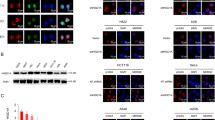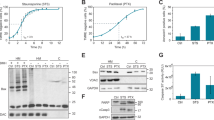Abstract
Many anticancer drugs, such as doxorubicin (DXR), intercalate into nuclear DNA of cancer cells, thereby inhibiting their growth. However, it is not well understood how such drugs interact with mitochondrial DNA (mtDNA). Using cell and molecular studies of cultured cells, we show that DXR and other DNA intercalators, such as ethidium bromide, can rapidly intercalate into mtDNA within living cells, causing aggregation of mtDNA nucleoids and altering the distribution of nucleoid proteins. Remodelled nucleoids excluded DXR and maintained mtDNA synthesis, whereas non-remodelled nucleoids became heavily intercalated with DXR, which inhibited their replication, thus leading to mtDNA depletion. Remodelling was accompanied by extensive mitochondrial elongation or interconnection, and was suppressed in cells lacking mitofusin 1 and optic atrophy 1 (OPA1), the key proteins for mitochondrial fusion. In contrast, remodelling was significantly increased by p53 or ataxia telangiectasia mutated inhibition (ATM), indicating a link between nucleoid dynamics and the genomic DNA damage response. Collectively, our results show that DNA intercalators can trigger a common mitochondrial response, which likely contributes to the marked clinical toxicity associated with these drugs.
This is a preview of subscription content, access via your institution
Access options
Subscribe to this journal
Receive 50 print issues and online access
$259.00 per year
only $5.18 per issue
Buy this article
- Purchase on Springer Link
- Instant access to full article PDF
Prices may be subject to local taxes which are calculated during checkout





Similar content being viewed by others
References
Abramoff MD, Magelhaes PJ, Ram SJ . (2004). Image processing with ImageJ. Biophotonics Int 11: 36–42.
Achanta G, Sasaki R, Feng L, Carew JS, Lu W, Pelicano H et al. (2005). Novel role of p53 in maintaining mitochondrial genetic stability through interaction with DNA Pol gamma. EMBO J 24: 3482–3492.
Ashley N, Adams S, Slama A, Zeviani M, Suomalainen A, Andreu AL et al. (2007). Defects in maintenance of mitochondrial DNA are associated with intramitochondrial nucleotide imbalances. Hum Mol Genet 16: 1400–1411.
Ashley N, Harris D, Poulton J . (2005). Detection of mitochondrial DNA depletion in living human cells using PicoGreen staining. Exp Cell Res 303: 432–446.
Ashley N, O'Rourke A, Smith C, Adams S, Gowda V, Zeviani M et al. (2008). Depletion of mitochondrial DNA in fibroblast cultures from patients with POLG1 mutations is a consequence of catalytic mutations. Hum Mol Genet 17: 2496–2506.
Ashley N, Poulton J . (2009). Mitochondrial DNA is a direct target of anti-cancer anthracycline drugs. Biochem Biophys Res Commun 378: 450–455.
Bakhanashvili M, Grinberg S, Bonda E, Rahav G . (2009). Excision of nucleoside analogs in mitochondria by p53 protein. AIDS 27: 779–788.
Bakhanashvili M, Grinberg S, Bonda E, Simon AJ, Moshitch-Moshkovitz S, Rahav G . (2008). p53 in mitochondria enhances the accuracy of DNA synthesis. Cell Death Differ 15: 1865–1874.
Bogenhagen DF, Rousseau D, Burke S . (2008). The layered structure of human mitochondrial DNA nucleoids. J Biol Chem 283: 3665–3675.
Chen H, Chomyn A, Chan DC . (2005a). Disruption of fusion results in mitochondrial heterogeneity and dysfunction. J Biol Chem 280: 26185–26192.
Chen H, Detmer SA, Ewald AJ, Griffin EE, Fraser SE, Chan DC . (2003). Mitofusins Mfn1 and Mfn2 coordinately regulate mitochondrial fusion and are essential for embryonic development. J Cell Biol 160: 189–200.
Chen XJ, Wang X, Kaufman BA, Butow RA . (2005b). Aconitase couples metabolic regulation to mitochondrial DNA maintenance. Science 307: 714–717.
Cipolat S, Martins de Brito O, Dal Zilio B, Scorrano L . (2004). OPA1 requires mitofusin 1 to promote mitochondrial fusion. Proc Natl Acad Sci USA 101: 15927–15932.
Conklin KA . (2005). Coenzyme q10 for prevention of anthracycline-induced cardiotoxicity. Integr Cancer Ther 4: 110–130.
Cullinane C, Cutts SM, Panousis C, Phillips DR . (2000). Interstrand cross-linking by adriamycin in nuclear and mitochondrial DNA of MCF-7 cells. Nucleic Acids Res 28: 1019–1025.
Ellis CN, Ellis MB, Blakemore WS . (1987). Effect of adriamycin on heart mitochondrial DNA. Biochem J 245: 309–312.
Emmerson CF, Brown GK, Poulton J . (2001). Synthesis of mitochondrial DNA in permeabilised human cultured cells. Nucleic Acids Res 29: E1.
Felix CA, Kappel CC, Mitsudomi T, Nau MM, Tsokos M, Crouch GD et al. (1992). Frequency and diversity of p53 mutations in childhood rhabdomyosarcoma. Cancer Res 52: 2243–2247.
Garrido N, Griparic L, Jokitalo E, Wartiovaara J, van der Bliek AM, Spelbrink JN . (2003). Composition and dynamics of human mitochondrial nucleoids. Mol Biol Cell 14: 1583–1596.
Griparic L, Kanazawa T, van der Bliek AM . (2007). Regulation of the mitochondrial dynamin-like protein Opa1 by proteolytic cleavage. J Cell Biol 178: 757–764.
Hande KR . (1998). Clinical applications of anticancer drugs targeted to topoisomerase II. Biochim Biophys Acta 1400: 173–184.
He J, Mao CC, Reyes A, Sembongi H, Di Re M, Granycome C et al (2007). The AAA+ protein ATAD3 has displacement loop binding properties and is involved in mitochondrial nucleoid organization. J Cell Biol 176: 141–146.
Hixon SC, Ellis CN, Daugherty JP . (1981). Heart mitochondrial DNA synthesis: preferential inhibition by adriamycin. J Mol Cell Cardiol 13: 855–860.
Iborra FJ, Kimura H, Cook PR . (2004). The functional organization of mitochondrial genomes in human cells. BMC Biol 2: 9.
Jung K, Reszka R . (2001). Mitochondria as subcellular targets for clinically useful anthracyclines. Adv Drug Deliv Rev 49: 87–105.
Kucej M, Kucejova B, Subramanian R, Chen XJ, Butow RA . (2008). Mitochondrial nucleoids undergo remodeling in response to metabolic cues. J Cell Sci 121: 1861–1868.
Kurz EU, Douglas P, Lees-Miller SP . (2004). Doxorubicin activates ATM-dependent phosphorylation of multiple downstream targets in part through the generation of reactive oxygen species. J Biol Chem 279: 53272–53281.
Lebrecht D, Kokkori A, Ketelsen UP, Setzer B, Walker UA . (2005). Tissue-specific mtDNA lesions and radical-associated mitochondrial dysfunction in human hearts exposed to doxorubicin. J Pathol 207: 436–444.
Lebrecht D, Setzer B, Rohrbach R, Walker UA . (2004). Mitochondrial DNA and its respiratory chain products are defective in doxorubicin nephrosis. Nephrol Dial Transplant 19: 329–336.
Legros F, Malka F, Frachon P, Lombes A, Rojo M . (2004). Organization and dynamics of human mitochondrial DNA. J Cell Sci 117: 2653–2662.
Magnusson J, Orth M, Lestienne P, Taanman JW . (2003). Replication of mitochondrial DNA occurs throughout the mitochondria of cultured human cells. Exp Cell Res 289: 133–142.
Martinez LA, Naguibneva I, Lehrmann H, Vervisch A, Tchenio T, Lozano G et al. (2002). Synthetic small inhibiting RNAs: efficient tools to inactivate oncogenic mutations and restore p53 pathways. Proc Natl Acad Sci USA 99: 14849–14854.
McKenzie PP, McPake CR, Ashford AA, Vanin EF, Harris LC . (2002). MDM2 does not influence p53-mediated sensitivity to DNA-damaging drugs. Mol Cancer Ther 1: 1097–1104.
Nithipongvanitch R, Ittarat W, Velez JM, Zhao R, St Clair DK, Oberley TD . (2007). Evidence for p53 as guardian of the cardiomyocyte mitochondrial genome following acute adriamycin treatment. J Histochem Cytochem 55: 629–639.
Olichon A, Baricault L, Gas N, Guillou E, Valette A, Belenguer P et al. (2003). Loss of OPA1 perturbates the mitochondrial inner membrane structure and integrity, leading to cytochrome c release and apoptosis. J Biol Chem 278: 7743–7746.
Poulton J, Morten K, Freeman-Emmerson C, Potter C, Sewry C, Dubowitz V et al. (1994). Deficiency of the human mitochondrial transcription factor h-mtTFA in infantile mitochondrial myopathy is associated with mtDNA depletion. Hum Mol Genet 3: 1763–1769.
Singal PK, Iliskovic N . (1998). Doxorubicin-induced cardiomyopathy. N Engl J Med 339: 900–905.
Steinherz L, Steinherz P . (1991). Delayed cardiac toxicity from anthracycline therapy. Pediatrician 18: 49–52.
Suliman HB, Carraway MS, Ali AS, Reynolds CM, Welty-Wolf KE, Piantadosi CA . (2007). The CO/HO system reverses inhibition of mitochondrial biogenesis and prevents murine doxorubicin cardiomyopathy. J Clin Invest 117: 3730–3741.
Tokarska-Schlattner M, Wallimann T, Schlattner U . (2006). Alterations in myocardial energy metabolism induced by the anti-cancer drug doxorubicin. C R Biol 329: 657–668.
Tondera D, Grandemange S, Jourdain A, Karbowski M, Mattenberger Y, Herzig S et al. (2009). SLP-2 is required for stress-induced mitochondrial hyperfusion. EMBO J 28: 1589–1600.
Trifunovic A, Wredenberg A, Falkenberg M, Spelbrink JN, Rovio AT, Bruder CE et al. (2004). Premature ageing in mice expressing defective mitochondrial DNA polymerase. Nature 429: 417–423.
von Wurmb-Schwark N, Cavelier L, Cortopassi GA . (2006). A low dose of ethidium bromide leads to an increase of total mitochondrial DNA while higher concentrations induce the mtDNA 4997 deletion in a human neuronal cell line. Mutat Res 596: 57–63.
Wallace KB . (2003). Doxorubicin-induced cardiac mitochondrionopathy. Pharmacol Toxicol 93: 105–115.
Zhou S, Palmeira CM, Wallace KB . (2001). Doxorubicin-induced persistent oxidative stress to cardiac myocytes. Toxicol Lett 121: 151–157.
Acknowledgements
We thank I Sargent for providing the equipment; E Brampton, M Zeviani, I Holt, B Roques, A Trifunovic, P Cook and D Chan for materials; and K Morten and F Brook for technical support. This work was funded by the MRC/Wellcome Trust.
Author information
Authors and Affiliations
Corresponding author
Additional information
Supplementary Information accompanies the paper on the Oncogene website (http://www.nature.com/onc)
Rights and permissions
About this article
Cite this article
Ashley, N., Poulton, J. Anticancer DNA intercalators cause p53-dependent mitochondrial DNA nucleoid re-modelling. Oncogene 28, 3880–3891 (2009). https://doi.org/10.1038/onc.2009.242
Received:
Revised:
Accepted:
Published:
Issue Date:
DOI: https://doi.org/10.1038/onc.2009.242
Keywords
This article is cited by
-
Safeguarding mitochondrial genomes in higher eukaryotes
Nature Structural & Molecular Biology (2020)
-
Live imaging reveals the dynamics and regulation of mitochondrial nucleoids during the cell cycle in Fucci2-HeLa cells
Scientific Reports (2017)
-
Increased cellular accumulation and distribution of amrubicin contribute to its activity in anthracycline-resistant cancer cells
Cancer Chemotherapy and Pharmacology (2012)



